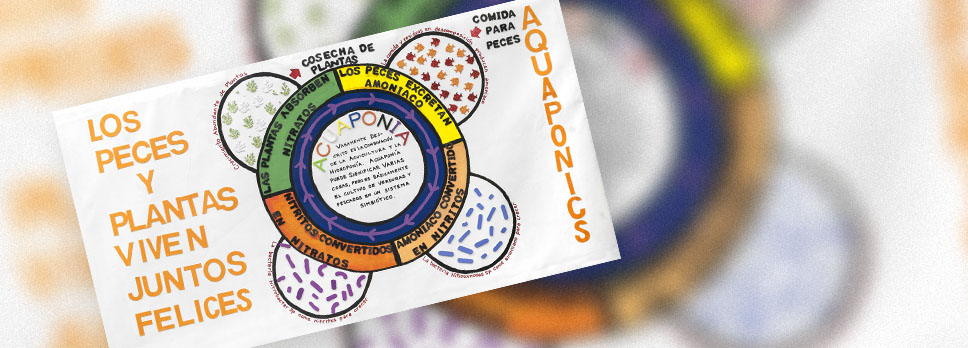Peces y Plantas—Juntos Felices
First, find an afterschool teen pregnancy prevention program for underserved Baltimore Latino high school students. Then put those teenagers inside a greenhouse that supports a delicate aquaponics demonstration project. What do you get? For starters, a lively translation project that reaches out to Spanish-speaking communities. Check out the photo (enlarged) of the colorful final product.
“Es básicamente el cultivo de verduras y pescados en un sistema simbiótico.”
Beautifully, the mural explains the cycle employed by the Center for a Livable Future Aquaponics Project at Cylburn—plants and fish nurture each other symbiotically in this (mostly) closed system. The four-step cycle is as follows: fish excrete ammonia; bacteria convert the ammonia into nitrites; different bacteria convert nitrites into nitrates; and the plants consume the nitrates. Ahí está. Plants, such as bok choy and lettuce, are harvested, and the tilapia flourish. One day, the idea goes, the tilapia will be sold to food service institutions that support sustainable aquaculture. The only element that comes from outside the system is the food used to feed the fish, which, in this project, is entirely vegetarian and organic.
The assignment was to translate, into Spanish, some information materials for the Aquaponics Project. The students came to us from a program called Mi Espacio, which is run by the City’s Health Department (but will shut down after 11 years for lack of funding); they landed at Cylburn through a connection with Lina Oliveros, a TogetherGreen fellow who has been funded to work with another Baltimore aquaculture project with similar goals.
Oliveros has been collaborating with the Raising Prawns in the City project (formerly the Prawn Shop); this project’s goal is to create a sustainable food production system that combines a traditional aquaculture with hydroponics in a symbiotic environment. As Oliveros points out, current shrimp farming practices are damaging the unique mangrove ecosystem. “Growing prawns in a city setting can be an alternative to harvesting shrimp from natural waters,” she says.
The Aquaponics Project, directed by Dave Love, PhD, and managed by Laura Genello, hosts open hours every week for groups who want to tour the facility and learn more about the theory-in-action. “It’s always a pleasure to have student groups out to tour the project,” says Genello. “It’s great to see the kids’ eyes light up when they realize the connection between the fish and the plants, and this group asked a lot of great questions.”
